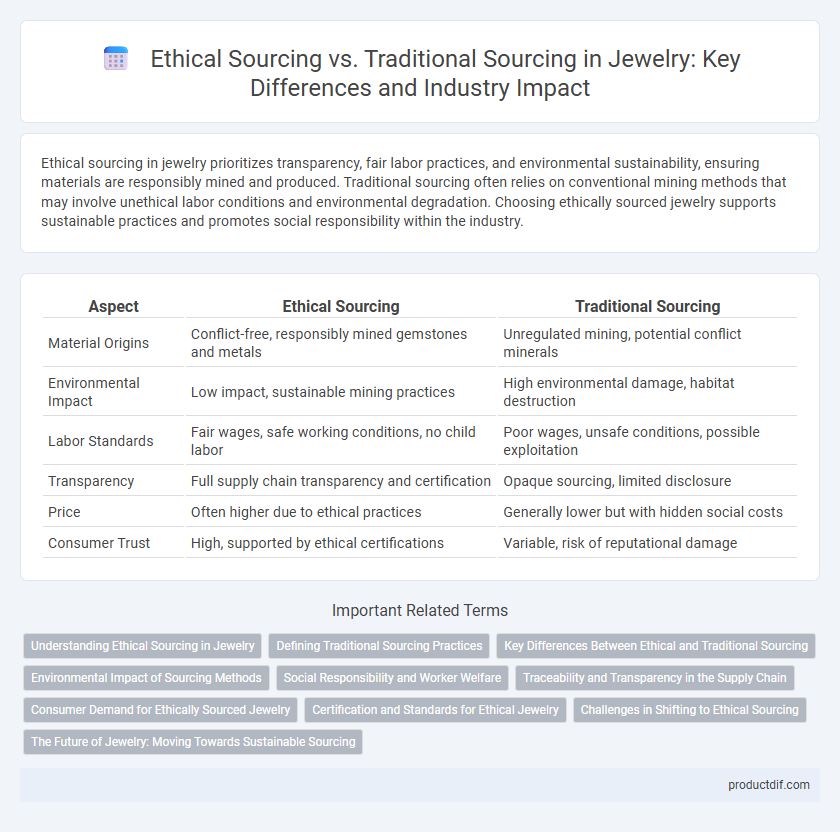Ethical sourcing in jewelry prioritizes transparency, fair labor practices, and environmental sustainability, ensuring materials are responsibly mined and produced. Traditional sourcing often relies on conventional mining methods that may involve unethical labor conditions and environmental degradation. Choosing ethically sourced jewelry supports sustainable practices and promotes social responsibility within the industry.
Table of Comparison
| Aspect | Ethical Sourcing | Traditional Sourcing |
|---|---|---|
| Material Origins | Conflict-free, responsibly mined gemstones and metals | Unregulated mining, potential conflict minerals |
| Environmental Impact | Low impact, sustainable mining practices | High environmental damage, habitat destruction |
| Labor Standards | Fair wages, safe working conditions, no child labor | Poor wages, unsafe conditions, possible exploitation |
| Transparency | Full supply chain transparency and certification | Opaque sourcing, limited disclosure |
| Price | Often higher due to ethical practices | Generally lower but with hidden social costs |
| Consumer Trust | High, supported by ethical certifications | Variable, risk of reputational damage |
Understanding Ethical Sourcing in Jewelry
Ethical sourcing in jewelry prioritizes responsibly obtained raw materials, ensuring minimal environmental impact and fair labor practices throughout the supply chain. This approach contrasts with traditional sourcing, which may overlook the social and ecological consequences of mining and production. Consumers increasingly demand transparency and sustainability, driving jewelers to adopt certifications and traceability standards that verify ethically sourced gemstones and metals.
Defining Traditional Sourcing Practices
Traditional sourcing practices in jewelry primarily involve mining and acquiring gemstones and precious metals from established suppliers without extensive oversight of environmental or social impacts. These methods often prioritize cost-efficiency and supply chain speed, sometimes overlooking labor conditions and ecological sustainability. Conventional sourcing relies on long-standing trade networks that may lack transparency and traceability compared to emerging ethical standards.
Key Differences Between Ethical and Traditional Sourcing
Ethical sourcing in jewelry emphasizes transparency, fair labor practices, and environmental sustainability, ensuring materials are obtained without exploiting workers or damaging ecosystems. Traditional sourcing often prioritizes cost and supply chain efficiency over social and environmental concerns, sometimes leading to unethical labor conditions and ecological harm. Key differences include the traceability of raw materials and the commitment to responsible mining and production standards in ethical sourcing.
Environmental Impact of Sourcing Methods
Ethical sourcing in jewelry prioritizes responsible mining practices that minimize habitat destruction, reduce water pollution, and lower carbon emissions compared to traditional methods. Traditional sourcing often involves large-scale mining operations that cause significant environmental degradation, including soil erosion and toxic runoff. By adopting traceability and certification standards like Fairtrade and Responsible Jewellery Council, brands ensure reduced ecological footprints and promote sustainable resource management.
Social Responsibility and Worker Welfare
Ethical sourcing in jewelry emphasizes fair labor practices, ensuring artisans and workers receive fair wages, safe working conditions, and respect for their rights, contrasting sharply with traditional sourcing often linked to exploitative labor and unsafe environments. Brands committed to ethical sourcing prioritize transparency in their supply chains, reducing harm to communities and promoting worker welfare throughout the mining and crafting processes. This approach fosters social responsibility, empowering local populations and supporting sustainable livelihoods while minimizing environmental impact.
Traceability and Transparency in the Supply Chain
Ethical sourcing in jewelry emphasizes full traceability and transparency throughout the supply chain, ensuring that materials are responsibly mined and sold without exploitation or environmental harm. Traditional sourcing often lacks comprehensive visibility, making it difficult to verify the origins of gemstones and precious metals or to guarantee fair labor practices. Advanced technologies like blockchain and third-party certification provide verifiable data that strengthen consumer trust and promote sustainable industry standards.
Consumer Demand for Ethically Sourced Jewelry
Consumer demand for ethically sourced jewelry has surged, driven by increased awareness of environmental impact and labor practices in traditional sourcing. Shoppers are prioritizing transparency, fair trade certifications, and conflict-free materials over conventional options tied to exploitative mining. This shift pushes brands to adopt sustainable sourcing policies, emphasizing cruelty-free gemstones and recycled metals to meet ethical expectations.
Certification and Standards for Ethical Jewelry
Ethical jewelry sourcing prioritizes certification programs such as Fairmined, Fairtrade, and Responsible Jewellery Council (RJC) standards, ensuring transparency and social responsibility in mining practices. These certifications mandate adherence to strict environmental regulations, fair labor conditions, and accountable supply chains, contrasting with traditional sourcing where such oversight may be lacking. Consumers seeking sustainable and conflict-free jewelry often rely on these verified standards to guarantee ethical provenance and minimize ecological impact.
Challenges in Shifting to Ethical Sourcing
Shifting to ethical sourcing in jewelry presents challenges such as increased costs due to fair labor practices and sustainable materials, which can impact pricing and profit margins. Limited availability of ethically sourced gemstones and metals complicates supply chain logistics and consistency. Furthermore, transparency requirements demand rigorous auditing and certification processes, adding operational complexity for jewelers committed to ethical standards.
The Future of Jewelry: Moving Towards Sustainable Sourcing
Sustainable sourcing in jewelry prioritizes ethically mined gemstones and recycled metals to minimize environmental impact and support fair labor practices. Innovations in traceability technology enhance transparency, allowing consumers to verify the origin and ethical standards of their jewelry. The future of jewelry manufacturing increasingly hinges on integrating these sustainable practices to meet growing consumer demand for responsibility and authenticity.
Ethical Sourcing vs Traditional Sourcing Infographic

 productdif.com
productdif.com